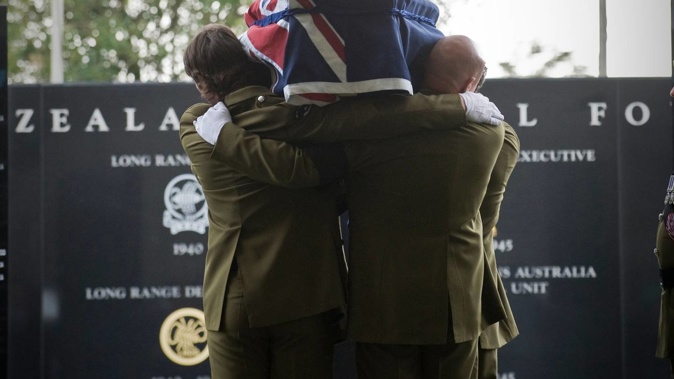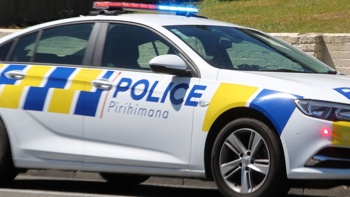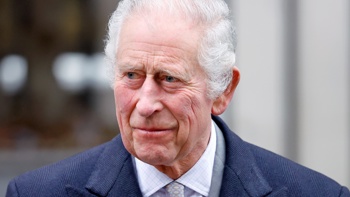
Our elite New Zealand Special Air Service (NZSAS) is considering removing the name and insignia of the colonial Forest Rangers unit from its "most sacred" memorial as our military begins to reconcile its colonial roots with modern New Zealand.
The move by the NZSAS recognises the "Euro-centric" shaping of our shared history and reflects a growing appreciation of the complex, shifting sands on which modern New Zealand is founded.
Special Operations Component Commander Colonel Duncan Roy said discussions began with the recent commemorations of the New Zealand Army's 175th anniversary "and we started reflecting about where we started and the New Zealand Wars".
Roy said the discussion was about "how we reconcile how New Zealand used to view things and how we view things as a society now".
"Our history was written from a Euro-centric point of view," he said.
The NZSAS' links to the Forest Rangers run almost the course of its 67-year history. Formed in 1955, it was renamed 1 Ranger Squadron NZSAS in 1963 as a nod to the colonial troop, until 1978 when the name changed again.
The gruelling NZSAS selection course includes Exercise von Tempsky, named for Gustavus Ferdinand von Tempsky, one of the commanders of the Forest Rangers. Candidates march for more than 20 hours in rough terrain wearing full packs and carrying 20-kilo jerry cans.
At its Papakura base, there is a remembrance garden that includes a marble memorial with four panels that commemorate "New Zealand Special Forces". The Forest Rangers is the first of the four panels and the only one from the 19th century.
Not far from there - and even closer to the New Zealand Defence Force's (NZDF) nearby Battle Training Facility - the Forest Rangers carried out the last armed attack of the New Zealand Wars in South Auckland in December 1863.
/cloudfront-ap-southeast-2.images.arcpublishing.com/nzme/SBYVUZHQQGBZRHVBBSZSHWIMHU.jpg) The NZSAS at the Ardmore Battle Training Facility, not far from where the Forest Rangers carried out an attack that was later called "murder". Photo / Mike Scott
The NZSAS at the Ardmore Battle Training Facility, not far from where the Forest Rangers carried out an attack that was later called "murder". Photo / Mike Scott
It was an incident that prompted outrage even then with accusations of "cold-blooded murder" after evidence the troops fired into an unsuspecting group that included women and children during Sunday prayers.
Of the Forest Rangers' role, Roy said: "Back then, I think that's where people looked at it [with] a more Euro-centric view and now we're looking at it from all sides."
Roy - as with others interviewed - spoke of how incorporating other views and understanding other narratives meant "looking at things through different lenses". Doing so incorporated Māori who resisted the Crown and those who fought alongside the Crown, as well as more well-travelled colonial and imperial views.
Roy referred to the "amazing martial feats" of leaders and warriors such as Te Keepa - also known as Te Rangihiwinui - who spent six years in service to the Crown fighting around Whanganui, and Te Kooti Arikirangi Te Tūruki, who led a series of victories against colonial forces.
He said the effort being made to broaden an understanding of the NZSAS fit with the regiment's determination to break ground.
"For us, one of our tenets is the unrelenting persistence of excellence. Evolution is a key part of who we are. We do that in all parts of our culture, organisation, tactics and techniques."
Asked if possible changes extended to the memorial, Roy said: "What I would say about the memorial is it's the most sacred part of our organisation. It has the names of our dead on it. Everybody needs to be able to come to the memorial and connect to it."
/cloudfront-ap-southeast-2.images.arcpublishing.com/nzme/BPM4YFMBVXJIP4OUVU5HKJDT74.jpg) The memorial at the NZSAS base at Papakura included, at far left, the Forest Rangers. Photo / Mike Scott
The memorial at the NZSAS base at Papakura included, at far left, the Forest Rangers. Photo / Mike Scott
He said the Forest Rangers panel could be seen by some as a barrier to that connection.
The memorial carries the elaborate interlinked initials of the Forest Rangers, as it does the symbols associated with other units such as the Long Range Desert Group or Z Special Unit, which both fought in World War II.
Roy said he was interested in finding whether it was possible to develop an insignia or symbol that encompassed conflict in colonial times regardless of the role played.
"If we do make changes, we want them to be enduring and they need to be wider than us. We're not in a hurry to do this. These are big changes."
Roy said discussions so far were largely inside the regiment but would expand to incorporate former NZSAS personnel and other stakeholders.
The size of the task is enormous and, as author, historian and Waitangi Tribunal member Ron Crosby describes, deeply complex. "There is an increasing tendency to try and paint a binary picture - Crown versus Māori - and it's too simplistic," Crosby said.
"It's not Crown on one side and Māori on the other. It's not good and evil."
This is why, said Crosby, he wrote the book Kupapa, which told the story of Māori allied to the Crown during the New Zealand Wars.
Crosby, who also wrote the official history of the NZSAS (NZSAS: The First Fifty Years), said the Forest Rangers were at the "lighter end" of what might be described as special forces which conducted "discrete targeted operations beyond the capability of conventional forces".
The emergence of long-range and targeted insertions - such as the NZSAS might be called on to do - was itself a reflection of a shift in our history as the British Empire limited the availability of Imperial troops to be used in land grabs.
Without the "unstoppable force" of the Imperial army, the settler government turned to building alliances and enlisting Māori forces that could carry out or counter guerilla warfare.
/cloudfront-ap-southeast-2.images.arcpublishing.com/nzme/IP6JJMOD2A2CFKHK6YVMZE4JL4.jpg) Camp of the 40th Regiment, Imperial Forces, at Baird's farm, Ramarama South Auckland in 1863 or 1864. Photo / Alexander Turnball Library
Camp of the 40th Regiment, Imperial Forces, at Baird's farm, Ramarama South Auckland in 1863 or 1864. Photo / Alexander Turnball Library
"What's happened up until now is there has only been a recognition on the Pākehā side and that needs to be balanced. It's reflective of the Euro-centric approach we've had to our education system for the past 100 years."
By casting a wider net, Crosby brings in others who better fit the "special forces" description, such as Te Keepa, Ropata Wahawaha, Rēnata Kawepō and Hēnare Tōmoana.
"They carried out these amazing long-distance campaigns. These are complex Māori-on-Māori operations." Exhibiting strong leadership, they took "tough young warriors" on operations that lasted weeks and months, across great distances.
Other notable mentions include Te Arawa Flying Columns, two units of 70 men apiece led by Captain George Preece and Captain Gilbert Mair, which carried out incursions into Te Urewera in search of Te Kooti and his followers. "The people they were pursuing were as good as anybody."
"I went through school and never heard of these blokes," said Crosby. In balance, he points to Te Kooti and Riwha Tītokowaru who were similarly warriors of renown.
Crosby suspects that those who wrapped the Forest Rangers and von Tempsky into NZSAS mythos had, like him, not grown up with the names or deeds of Māori warriors on either side of the conflict.
The Forest Rangers rose to fame largely through the invasion of Waikato in 1863. The invasion was premised on an ultimatum that painted a picture of rebellious "armed bands" preparing for Auckland. It demanded Māori in Waikato lay down weapons and swear allegiance to the Crown.
Historian Chris Pugsley called Grey's ultimatum "cynical and dishonest" - troops had set out before it even arrived. It led to nine months of skirmishing and sporadic intense battles which then saw wholesale confiscation of land as retribution for what the colonial government styled as the Māori rebellion.
/cloudfront-ap-southeast-2.images.arcpublishing.com/nzme/MJUWUXCDRBP2RPNNOI3WH4WZYQ.jpg) Historian Christopher Pugsley. Photo / Supplied
Historian Christopher Pugsley. Photo / Supplied
It was an extraordinary deceit, as was acknowledged 132 years later. In the Waikato-Tainui agreement of 1995 the Crown said it acted "unjustly and in breach of the Treaty of Waitangi" by "unfairly labelling Waikato as rebels" and sending its forces south.
The settlement acknowledges the death caused by the Crown's unjust and unfair acts which wrought "devastation of property and social life". The wrongful confiscation that followed enriched New Zealand while it "had a crippling impact on the welfare, economy and development of Waikato".
There are names that speak to key points in the conflict: the first battle at Koheroa, the strategic maneuvering at Meremere; then Rangiriri with its many deaths and muddled conclusion, the siege of Pāterangi, the burning of Rangiaowhia, the desperate defence of Hairini and the final, awful butchery at Ōrākau.
Each step of the way, the Forest Rangers joined Imperial forces in carving a path through Waikato to crush the forced, defensive resistance to an unjust and unwarranted invasion.
Pugsley also spoke of complexity and context when reflecting on the actions of troops acting on behalf of the colonial government.
"The regiments that fought in the Waikato came from India and were conditioned by their view of native races. They took no prisoners. In some cases, they blew native Indians apart by putting them over the muzzles of canons."
There is context to be found in the period in which these actions took place and it expands to embrace all sides. Te Wherowhero, who was king and died in 1860, famously massacred prisoners of Te Ati Awa after a three-month siege, killing as many as 150 himself with his mere.
There is evidence, too, of a "take no prisoners" approach during World War I and World War II. "War is brutal," said Pugsley.
The name of von Tempsky has already been removed from a street sign in Hamilton with Tukoroirangi Morgan, chair of Waikato-Tainui's executive board Te Arataura, lending his influence to the campaign.
It came 27 years after Tainui's $170 million settlement with the Crown and recognition that the invasion of Waikato should never have happened.
Morgan said: "The view we took is the participation by the Forest Rangers is a reminder of the rawness of injustice at places like Rangiriri where hundreds of our men, women and children were slaughtered.
"The pain and the anguish goes that far. Rangiri, for us, are the killing fields of our people."
Morgan spoke of the alignment of the Forest Rangers with the NZSAS as a "contradiction" and a "dichotomy" - two things so different they cannot occupy the same space.
"You have generations of Māori who have served in that unit, who continue to serve in that unit... I have a single comment to the Defence Force - you should drop it, that von Tempsky and Forest Rangers link. It celebrates only one part of this country's history. It signifies anguish, pain, slaughter, murder.
"How can you have a Defence Force that incorporates these things when you have a Defence Force that represents all of us?"
/cloudfront-ap-southeast-2.images.arcpublishing.com/nzme/IMKAHII5I2E5M2IUGNWC3Q6HZA.jpg) Tukoroirangi Morgan, chairman of Waikato-Tainui's executive board Te Arataura. Photo / File
Tukoroirangi Morgan, chairman of Waikato-Tainui's executive board Te Arataura. Photo / File
Morgan said it was especially so as the NZSAS were seen as "the pinnacle of our fighting force".
"When people become members of the SAS, they have reached the top. You would think reaching the top would be far more embracing of all of our cultures, not the dark past of the atrocities committed by von Tempsky and the Forest Rangers."
Waitangi Tribunal member and academic Professor Dr Tom Roa (Ngāti Maniapoto, Waikato) described how the education system had wrapped itself around New Zealand history, effectively whitewashing it.
"Many of us were schooled to believe von Tempsky and the [Forest] Rangers were brave, courageous frontiersmen who were fighting for the glory of the British Empire," Roa said.
"Our tupuna told us a different story. For many of us who haven't heard this story still have the perspective von Tempsky was a dashing hero. I have a different understanding. I have heard the stories from the old people."
Roa said there was a generous forgiveness that came through those stories and a warning to not seek revenge. There was also an intergenerational silence, partly from trauma and also persecution of Māori for speaking of stories that did not fit with the accepted narrative.
An example, said Roa, was events at Rangiaowhia in February 1864 he has since described as a "war crime". "We have to look at history with an unjaundiced eye. We have to look at the context," he said.
The village of Rangiaowhia near Te Awamutu was the centre of extensive gardens cultivated and shared by Māori and Pākehā. Roa traces Pākehā ancestry to Thomas Power, who lived there with his wives Rahapa Te Hauata and Kahutoi Kaukau.
On February 21, 1864 Rangiaowhia - "the economic heartland of the Kīngitanga" was surprised by the arrival of Imperial and colonial forces, including von Tempsky and the Forest Rangers. It was a force that had skirted Pāterangi, where Rangiaowhia's fighting men were stationed.
/cloudfront-ap-southeast-2.images.arcpublishing.com/nzme/JLOPVFRHZAM5IM3DXLFQW73FWA.jpg) The attack on Rangiaowhia, an undefended agricultural hub in Waikato. Photo / Alexander Turnball Library
The attack on Rangiaowhia, an undefended agricultural hub in Waikato. Photo / Alexander Turnball Library
What happened next takes two different paths. In one history, which has travelled with New Zealand as it grew, "an excited cavalryman" fired into a whare and was killed when that shot was returned. His death spurred the invaders to line up and shoot into the building as those inside shot back, mortally wounding Colonel Marmaduke Nixon, settler and commander of the colonial cavalry.
In this history, it is unclear how the building caught fire but it came alight shortly after the Forest Rangers joined the fray. An unarmed elderly man came out waving a white blanket and was shot dead, as did two others who followed. The official record had it 12 Māori died at Rangiaowhia.
Then there's another pathway along which lie many more bodies. "We say in excess of 100 were killed," said Roa. "Not just killed but murdered, burned in their houses, and that von Temspky and his raiders played a role in that."
That pathway is one that describes an invading force out of control, destroying a peaceful settlement with no chance to defend itself. By one account, said Roa, von Tempsky attempted to stop his troops carrying out rape and murder.
"There always seem to be four or five sides to a story and the truth is very difficult to come to."
Roa spoke of the importance of New Zealand history being included in the core curriculum so generations to come would learn of incidents such as that which took place at Rangiaowhia.
In doing so, our shared history will come into sharper view without obscuring those parts which rose to prominence when only one narrative held sway.
Nixon's wounding at Rangiaowhia led to his death months later and then commemoration of his contribution to colonial New Zealand with a statue at Otahuhu. Talks continue with the Auckland Council over how to balance its presence with the untold story it presents.
"Many of our young people have asserted we should go and pull that statue down," said Roa. "No," he tells them, "we should tell the stories and those who put the statue there should bring it down... that they recognise the hurt it causes."
From next year, these stories will find a space to be told with the school curriculum expanding to incorporate New Zealand history. All who were interviewed for this story spoke with anticipation at the prospect of new generations learning our history, although there was also some caution urged as to how those stories might be told.
Crosby: "The complexity needs to be taught properly. One of the things that has to be done is that complexity does need to be taught in its full picture, not just the Crown-versus-Māori way it is put."
/cloudfront-ap-southeast-2.images.arcpublishing.com/nzme/EOCMMTGA6YCEBF47CNCWRFXTB4.jpg) Author and historian Ron Crosby with a fellow Waitangi Tribunal member at a hearing into the future of the Rena. Photo / File
Author and historian Ron Crosby with a fellow Waitangi Tribunal member at a hearing into the future of the Rena. Photo / File
Likewise, those whose roles are diminished by sharing space with others should not disappear. And we need to make space for those stories which might make us uncomfortable.
"You can't ignore that they existed. You shouldn't write them out of history."
Crosby points to Gallipoli and Turkey's willingness to have Australia and New Zealand commemorate losses suffered during an invasion on their soil.
"The Turks haven't stopped us calling it Anzac Cove and carrying out memorial services. In New Zealand, if we can recognise there were more than two sides, some of these people were standouts on all sides."
It's not about getting the right history. It's about getting history right.
Take your Radio, Podcasts and Music with you









